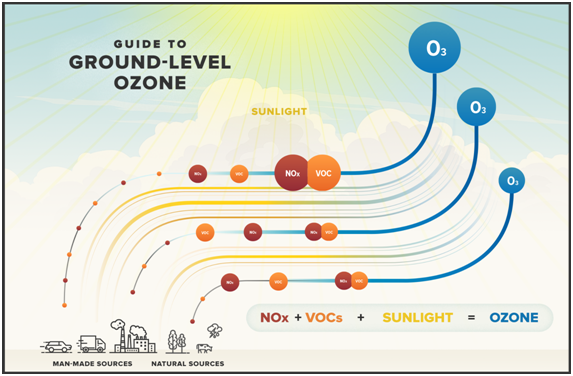Why in News?
- According to the Centre for Science and Environment (CSE), parts of the Delhi-NCR region witnessed ground-level ozone readings exceeding the safe standards (50 ppb over an 8-hour average) between March and May.
- Moreover, the region is seeing a rare phenomenon where ozone levels remain elevated even at night (should ideally become negligible during the night) and has become a yearlong problem.
What’s in Today’s Article?
- What is Ground-level Ozone?
- What are the Harmful Effects of Ground-level Ozone?
- What is the Situation of Ground-level Ozone in India?
What is Ground-level Ozone?

- Also known as tropospheric ozone, ground-level ozone is a colourless and highly irritating gas that forms just above the Earth’s surface (up to 2 miles above the ground).
- Ground-level ozone is a “secondary” pollutant - not directly emitted into the air but rather produced when two primary pollutantsreact in sunlight and stagnant air.
- These two primary pollutants are nitrogen oxides (NOx) and volatile organic compounds (VOCs).
- NOx and VOCs come from natural sources as well as human activities.
- About 95% of NOx from human activity comes from the burning of coal, gasoline and oil in motor vehicles, homes, industries and power plants.
- VOCs from human activity come mainly from gasoline production and combustion, residential wood combustion and from the evaporation of liquid fuels and solvents.
- Ground-level ozone is likely to breach safety standards on hot summer days in urban areas, but can also reach unhealthy levels during colder months.
- The pollutant can also travel long distances due to wind and affect rural areas
What are the Harmful Effects of Ground-level Ozone?
- On human health:
- As ground-level ozone is a highly reactive gas, it has serious health consequences.
- Those with respiratory conditions, asthma, chronic obstructive pulmonary disease and particularly children with premature lungs and older adults are at serious risk.
- This can inflame and damage airways, make lungs susceptible to infection, aggravate asthma, emphysema, and chronic bronchitis leading to increased hospitalisation.
- The pollutant can affect sensitive vegetation and ecosystems: Including forests, parks and wildlife refuges. Significantly, it can harm sensitive vegetation during the growing season too.
What is the Situation of Ground-level Ozone in India?
- In recent years, ground-level ozone has become a serious public health issue in India.
- According to the 2020 State of Global Air report,
- Seasonal 8-hour daily maximum concentrations have recorded one of the highest increases (17%) in India between 2010 and 2017.
- Age-standardised rates of death attributable to ground-level ozone are among the highest in the country.









